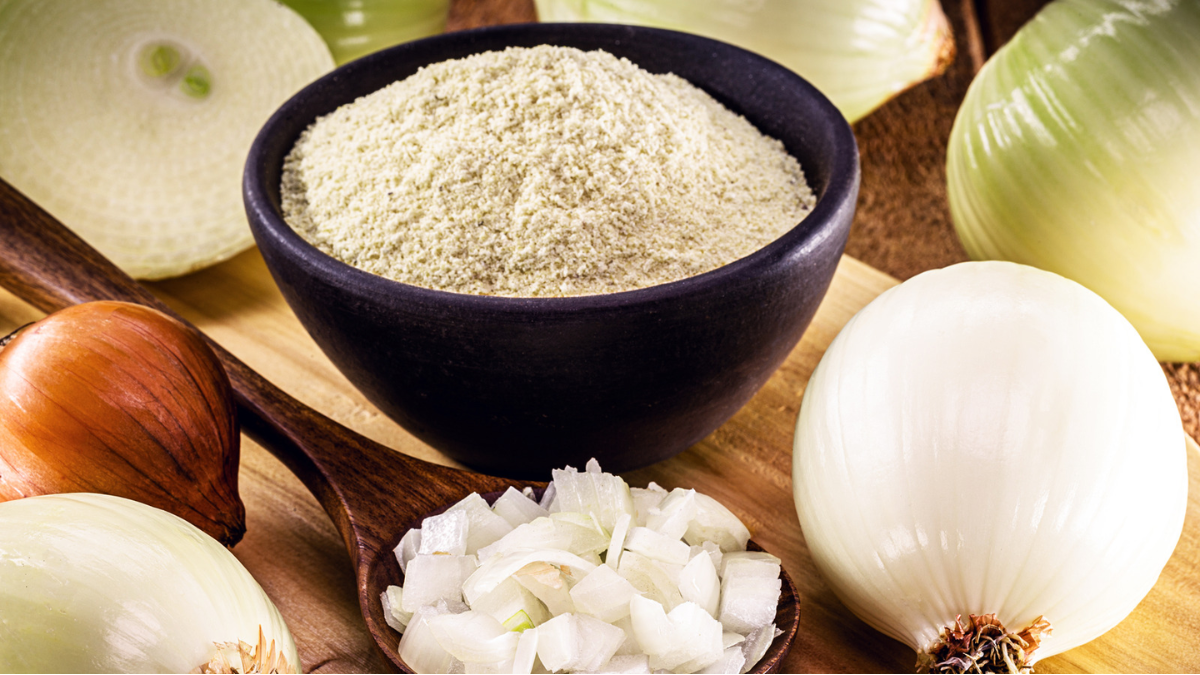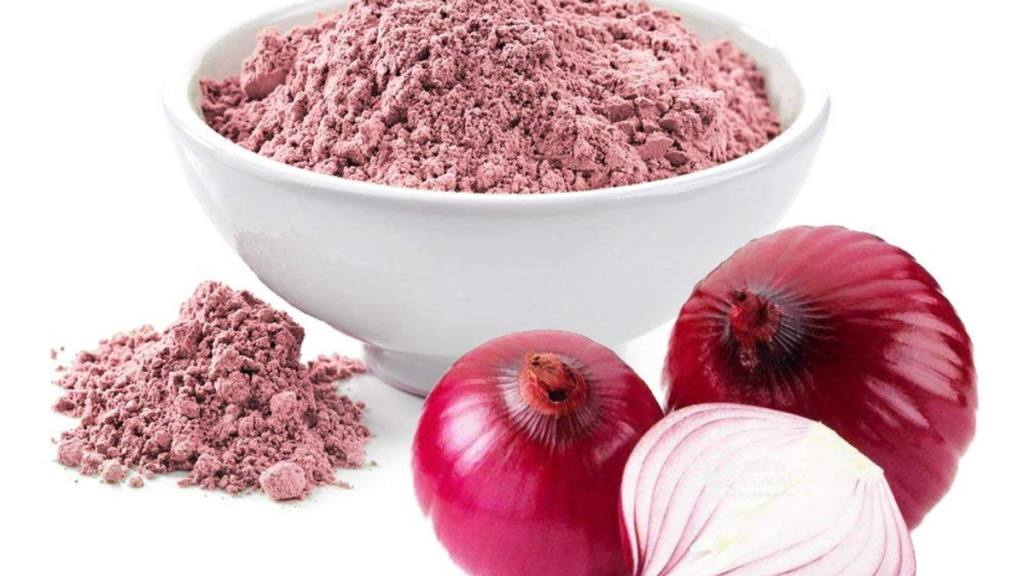Homemade Onion Powder will convince you that you will never need to buy pre-packaged onion powder again. You might also wish to make Onion Soup Mix and keep it on hand when a recipe calls for it. It’s simple to buy onion powder at your local supermarket, but you’ll never buy it again once you make your own. It’s also a lot easier to manufacture and has a superior flavor. Before rinsing and drying the onions, I decided to grate them. However, you could also chop them up by hand or food processor.
How to Make Onion Powder?
Onions! Unlike store-bought onion powder, you know your homemade onion powder contains only fresh onions. I used yellow onions in this recipe, but you could use any onion you have on hand. When producing homemade onion powder, there are a lot of factors to consider. I used a cheese grater to grate the onions for this dish. When I drained them, I got roughly a cup of onion juice using this approach.
You will not be able to obtain as much onion juice out of the onions if you chop them by hand. Peel the onions first, regardless of how you cut them. It’s time to drain the onions and extract that onion juice after you’ve grated (as I did), chopped, or used a food processor (on the pulse setting) to chop them. Place the onions in a fine wire mesh strainer set over a basin to drain.
One onion’s juice can be kept in the refrigerator for two weeks. It can marinate steaks, sprinkle on potatoes, add to soups or dips, or squeeze into any meal that requires a little onion flavor. Place the onion slices on parchment-lined baking pans, ensuring they don’t touch or overlap and bake at the lowest temperature possible.
It’s great if the temperature is between 130 and 150 degrees Fahrenheit/54 and 66 degrees Celsius. If your oven doesn’t go that low, set it to the lowest setting and prop the door open with a wooden spoon handle or something similar to enable more ventilation and steam to escape while the onion dehydrates. Check on the onion every hour, and flip it over a couple of times if you want it to dry out faster.
Ingredients
- Four big peeled onions
Instructions
- Preheat the oven to 170°F and parchment paper two baking sheets.
- Each onion should be peeled and grated with a cheese grater, making roughly 4 cups of liquid.
- Place the grated onions in a fine wire mesh strainer set over a bowl and gently press the onions with a spoon or your hands to extract as much juice as possible. (I got approximately a cup of liquid out of it.) Refrigerate the liquid in a tightly covered jar for up to two weeks.
- On each parchment-lined baking sheet, cut the onions in half and spread them out in a thin layer.
- Preheat the oven to 350°F and bake for 5 hours, or until thoroughly dry. It’s natural for the onions to turn pink, and please keep in mind that baking times may differ. When the onions crumble in your hand, you know they’re dry.
- Before crushing the dried onions, allow them to cool fully.
- To grind the onions, place them in a food processor and pulse until the appropriate consistency is achieved. For an even finer grain, a mortar and pestle can be used.
- Store the powder in an airtight container with a few grains of uncooked rice added to the powder to absorb any extra moisture.
What is the Shelf Life of Homemade Onion Powder?
It will keep in the refrigerator for up to 2 weeks in a sealed container, and I’ll give you some onion juice used just before the recipe card below. If stored properly, onion powder will keep its finest quality for 3 to 4 years.
Store onion powder purchased in bulk in containers with tight-fitting lids to extend its shelf life and preserve flavor and strength. If you manufacture fresh onion powder at home, it must be kept in the refrigerator. The shelf life of homemade onion powder is only 6 to 8 months.
Bugs inside the powder, moisture damage, a darker hue, and a lack of scent and flavor are all indicators that the powder has gone bad. In the conventional sense, dried herbs and spices do not expire or “go bad.” Most of its flavor, strength, and color has been lost when a spice has gone bad. Fortunately, taking spoiled spices is unlikely to make you sick.
What is the Best Way to Dry Onions at Home?
Dry onions until totally dry in a food dehydrator set to 100 to 130 degrees Fahrenheit. The slices should not flex but snap and break crisply in half. Spread onions thinly on a baking tray lined with parchment paper to dry in the oven.
Preheat the oven to 140°F and bake until crisp and dry. Onions do well in a shady, dry, and chilly environment, and this can be done in a shed or on a covered porch where it is not exposed to direct sunlight. Spread the onions out or hang them to allow air to flow and evenly dry the bulbs.
Long-term storage of larger onion kinds and onions with too much moisture can cause mold and rot; therefore, curing your onions is crucial. To cure onions, they must first be dried in the sun for a few days before being moved indoors to dry for two to three weeks.
Dry or cure the onions in a warm, well-ventilated spot after harvesting, such as a shed or garage. On a clean, dry surface, arrange the onions in a single layer. Cure the onions for two to three weeks, or until the tops and necks of the onions are completely dry and the outer bulb scales start to rustle.
Onion Salt Can Be Made At Home:
- To manufacture your onion salt, use three parts salt and one part onion powder. Please keep it in an airtight container until you’re ready to use it. Because there are no anti-caking chemicals in this recipe, you may need to whisk your onion salt before each use. If you don’t have any of the components for onion salt, you can substitute garlic salt, and it’ll give your food a similar flavor without adding extra texture or moisture.
- If all else fails, finely grated onion might be substituted. You certainly can. Onion salt was created by combining onion powder and salt. As a result, it has a taste and texture identical to onion powder, and onion powder is just crushed onions that have been dried.
- Although onion powder comprises dehydrated onion skins and roots, dried onion is merely the onion flesh. Because onion powder is three times stronger than dried onion, one tablespoon of onion powder would suffice in place of 1 cup of raw onion.
- Onion salt is one of those go-to spices everyone should have on hand. It’s a quick and easy method to add onion’s zingy flavor to a dish and salt’s tendency to level out and accentuate flavors. Use it in place of ordinary salt in any recipe.
Can you Make Onion Powder from Onion Flakes?
Pick up a package of onion flakes if you’re at the store. You can ground the flakes in a blender, use a mortar and pestle, or roll them with a rolling pin to get the texture of the onion powder. Onion flakes can be used in place of onion powder at a ratio.
Allow the dried onions to cool completely before pulverizing. A coffee grinder, spice mill, food processor, or mortar and pestle may quickly crush them. Continue to mill the mixture until it reaches the required consistency. Onion flakes are just finely chopped onions that have been allowed to dry.
A dehydrator machine speeds up the drying process by removing the moisture from the onions without frying them. Onion powder is made by extending the onion flakes manufacturing process. Onion powder can be replaced with various onions, including salt, fresh, and chopped onions. In a pinch, shallots, fennel bulbs, and celery can substitute for onion powder.
How Much Onion is in Onion Powder?
One medium onion, 1/2 cup chopped raw onion, or 1/4 cup minced onion equals one tablespoon of onion powder. When you don’t have time to cut onions, onion powder is a good substitute. 1 tablespoon of onion powder can be used instead of one medium chopped onion. Use frozen chopped onions or dried minced onion for the greatest onion flavor (found in the spice aisle).
On the other hand, onion powder is made from onions that have been dried (either air-dried, dehydrated, or freeze-dried) and crushed to various degrees, ranging from flakes to powder. There’s no texture, and no water and the onion flavor is more intense. The flavor of onion powder varies, exactly like fresh onions. Domestically grown, dried, and consistently minced to maintain color and flavor consistency.
Pure white onions have been used without any additions. They offer you a flavorful explosion without making you cry! If you don’t have onion powder, you can use 1 tablespoon of onion flakes for 1 teaspoon of the powder. Pound the flakes in a mortar and pestle if they need to be dissolved, such as in a sauce. Use the full flakes if you’re creating a dish like meatloaf.
Is There a Difference Between Garlic Powder and Onion Powder?
Garlic powder is made from powdered garlic cloves that have been dehydrated. On the other hand, onion bulbs are dried and processed into onion powder. Is there another onion powder alternative? Although it isn’t an identical flavor match, you can substitute half the amount of garlic powder for the onion powder.
In recipes, the two are frequently combined. Garlic powder, of course, has a garlicky flavor, but it also has a savory aspect similar to the powder. While many home cooks still use it, it is typically viewed as old school among chefs, food writers, and other tastemakers—not in an exciting or authentic sense, but in a snickering.
Can you believe people used to cook with condensed mushroom soup” kind of way? Any recipe that calls for fresh onion can be made with onion powder, and onion powder is a great addition to soups and stews. It powder is a must-have flavor for burgers, meatloaf, chili, skillet suppers, and other dishes. It powder is a natural fit for dry rubs.
Conclusion
Keep the onion powder in an airtight jar for several months. If you keep it in a cool, dry place, it will last longer. Before storing the powder, mix in a few uncooked rice grains. This will help to get rid of any excess moisture. Don’t forget to get the most out of the onion juice!
There are a few different ways to grind the onions to get that delectable powder. In a food processor, grind them down to your preferred consistency. For a finer grain, a mortar and pestle can be used. One solution I’ve seen is to use a coffee grinder. If you use a coffee grinder, on the other hand, you will very definitely never be able to use it for coffee again.

